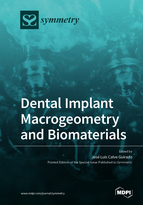Dental Implant Macrogeometry and Biomaterials
A special issue of Symmetry (ISSN 2073-8994). This special issue belongs to the section "Life Sciences".
Deadline for manuscript submissions: closed (31 December 2019) | Viewed by 15386
Special Issue Editor
2. Research Professor Department of Prosthodontics and Digital Technologies, School of Dental Medicine, State University of New York at Stony Brook, New York, NY, USA
Interests: dental implant design; biomedical engineering; types of biomaterials and bioceramics; dentin bone grafts; implant connection
Special Issues, Collections and Topics in MDPI journals
Special Issue Information
Dear Colleagues,
Implant design plays an important role in marginal bone maintenance and many different implant designs have attempted to preserve bone height after implant installation. Implant macrogeometry must reduce the stress on the bone surrounding the implant and stimulate bone remodeling. Surface characteristics also have a significant influence on marginal bone loss. In the case of hybrid implants, microgooves, micro-rings and flat surfaces, most of the implants present alveolar bone loss over the entire length of the flat surface, but SLA active and new bioactive surfaces will increase the bone to implant contact. New biomaterials made from bioglass, tooth grinded and silicate materials will increase new bone formation.
It is my immense pleasure to invite you to submit a manuscript to this Special Issue, “Dental Implant Macrogeometry and Biomaterials". Full research articles, short communications and comprehensive review papers covering all aspects of implant design, implant micro- and macrogeometry, and biomaterial engineering are welcome, as are papers on related topics.
Prof. Dr. José Luis Calvo Guirado
Guest Editor
Manuscript Submission Information
Manuscripts should be submitted online at www.mdpi.com by registering and logging in to this website. Once you are registered, click here to go to the submission form. Manuscripts can be submitted until the deadline. All submissions that pass pre-check are peer-reviewed. Accepted papers will be published continuously in the journal (as soon as accepted) and will be listed together on the special issue website. Research articles, review articles as well as short communications are invited. For planned papers, a title and short abstract (about 100 words) can be sent to the Editorial Office for announcement on this website.
Submitted manuscripts should not have been published previously, nor be under consideration for publication elsewhere (except conference proceedings papers). All manuscripts are thoroughly refereed through a single-blind peer-review process. A guide for authors and other relevant information for submission of manuscripts is available on the Instructions for Authors page. Symmetry is an international peer-reviewed open access monthly journal published by MDPI.
Please visit the Instructions for Authors page before submitting a manuscript. The Article Processing Charge (APC) for publication in this open access journal is 2400 CHF (Swiss Francs). Submitted papers should be well formatted and use good English. Authors may use MDPI's English editing service prior to publication or during author revisions.
Keywords
- dental implants
- macrogeometry
- biomaterials
- tooth graft
- hidroxyapatite
- bioglass






